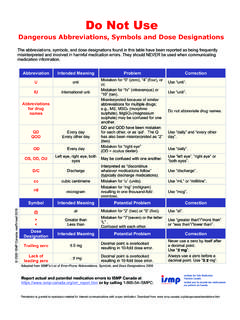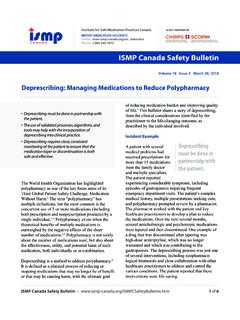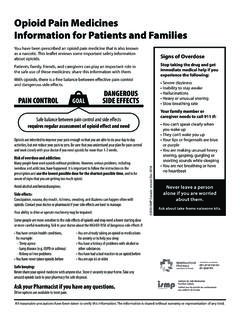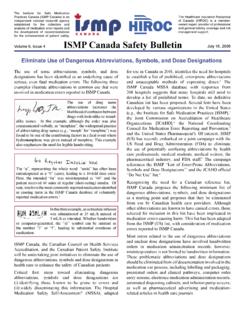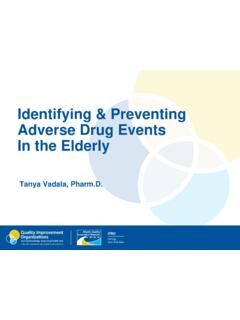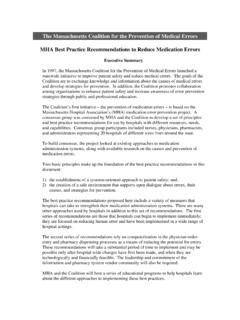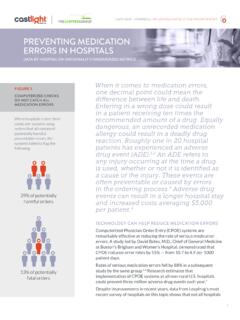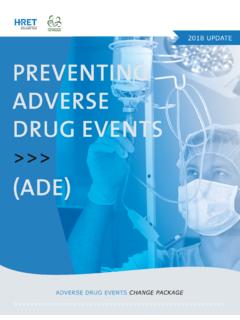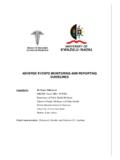Transcription of Patient Safety: Preventing Adverse Events OHA Conference
1 Safe Medication Practices Safe Medication Practices Patient safety : Patient safety : Preventing Adverse Events Preventing Adverse Events OHA ConferenceOHA ConferenceRenaissance Toronto Hotel at Renaissance Toronto Hotel at SkyDomeSkyDomeToronto Toronto June 14, 2004 June 14, 2004 David UDavid UPresident & CEO, ISMP CanadaPresident & CEO, ISMP CanadaAgendaAgenda ISMP Canada ISMP Canada Patient safety Studies in Canada Patient safety Studies in Canada Identified Medication related IssuesIdentified Medication related Issues Success Stories on Medication SafetySuccess Stories on Medication safety Proposed safety StrategiesProposed safety Strategies Medication safety ToolsMedication safety Tools Where do We Go from HereWhere do We Go from HereISMP Recent ProjectsISMP Recent Projects CMIRPS partnerCMIRPS partner Systems Analysis of Medication Systems Analysis of Medication Errors (SAME) Errors (SAME)
2 Ontario medication error databaseOntario medication error database Safe Medication Support ServiceSafe Medication Support Service Potassium ChloridePotassium Chloride Opiate NarcoticsOpiate Narcotics Infusion Pump SurveyInfusion Pump Survey CHCH--FMEA workshopFMEA workshopCanadian Study (results)Canadian Study (results) 289 289 AEsAEsfrom 3745 chartsfrom 3745 charts AE (1 in 13 hospitalizations) AE (1 in 13 hospitalizations) 37 % preventable37 % preventable App. 34% involved surgical eventsApp. 34% involved surgical Events App. 24% involved drugs and fluidsApp. 24% involved drugs and fluidsCanadian Study (Interpretation)Canadian Study (Interpretation) 185,000 185,000 AEsAEs 70,000 preventable70,000 preventable 43,200 43,200 AEsAEsrelated to Drugs/Fluidsrelated to Drugs/Fluids > 10,000 preventable > 10,000 preventable ADEsADEs Between 9,250 to 23,750 deaths from Between 9,250 to 23,750 deaths from AEsAEsin Canadian hospitalsin Canadian hospitalsResearch HighlightsResearch HighlightsBoston hospitalsBoston hospitals1997 (Bates et al)1997 (Bates et al)
3 Additional length of stay for additional length of stay for preventablepreventableADE = daysADE = days increase in cost for preventable ADE = increase in cost for preventable ADE = $5857$5857 cost for preventable ADE in 700cost for preventable ADE in 700--bed bed teaching hospital = $ millionteaching hospital = $ millionRelationship Between Med Relationship Between Med Errors and Errors and ADEsADEsIn a 200 bed facility:In a 200 bed facility:DosesDosesErrorsErrorsADEsADEs2 ,0002,000==200200= 2 per day!= 2 per day!Slide from the presentation on Analysis of Medication Errors in 36 Hospitals and SNFs, by Kenneth N. Barker, et al at ASHP Midyear Clinical Meeting, 2002. Relationship of Medication Relationship of Medication Errors to Errors to ADEsADEsBates study using chartBates study using chart--reviewreview--plusplus--selfself- -report method detected 1 report method detected 1 ADE per 100 per 100 DW, et al.
4 Relationship between medication errors and advBates DW, et al. Relationship between medication errors and Adverse erse drug Events . drug Events . J. Gen Intern Med J. Gen Intern Med 10:19910:199--205, 1995205, 1995 Canadian Canadian CollaborativesCollaboratives CMIRPSCMIRPS CCHSACCHSA OHAOHA Provincial Provincial OntarioOntario ManitobaManitoba SaskatchewanSaskatchewan Nova ScotiaNova Scotia British ColumbiaBritish Columbia AlbertaAlbertaAdverse Study on Adverse Study on Discharged PatientsDischarged patients Adverse Events among medical patients Adverse Events among medical patients after discharge from hospitalafter discharge from hospitalby Alan Forsterby Alan Forster 328 patients : 76 experienced AE (23%)328 patients : 76 experienced AE (23%) Most common Most common AEsAEsare are ADEsADEs(72%)(72%)Incidence and Severity of Adverse Incidence and Severity of Adverse Events After DischargeEvents After Discharge 400 medical inpatients400 medical inpatients Adverse event rate 19% Adverse event rate 19% 6% preventable6% preventable 48% of ADEs resulting in at least non48% of ADEs resulting in at least non--permanent disability preventablepermanent disability preventable 6% ameliorable6% ameliorable Of Adverse eventsOf Adverse Events 66% were ADEs66% were ADEs 17% procedure17% procedure--relatedrelatedForster et al, Ann Intern Med, 2003 PrePre--hospitalized AE Study hospitalized AE Study (Forster)(Forster) 502 adult patients in Ottawa Hospital502 adult patients in Ottawa Hospital 64 Adverse Events ( )64 Adverse Events ( )
5 One third deemed preventable one third deemed preventable Most Events due to drug TreatmentMost Events due to drug Treatment 25 after admission; 39 pre25 after admission; 39 pre--hospitalizedhospitalized safety must be addressed in ambulatory safety must be addressed in ambulatory care frontcare frontISMP CanadaISMP CanadaOntario Medication Error StudyOntario Medication Error Study A descriptive Study on Analysis of A descriptive Study on Analysis of Medication Errors from a sample of Ontario Medication Errors from a sample of Ontario hospitals using a standardized data hospitals using a standardized data collection approach of a software program collection approach of a software program (Analyze(Analyze--ERR)ERR) Make limited comparison with studies of Make limited comparison with studies of medication error and Adverse drug Events medication error and Adverse drug Events in the the CanadaISMP CanadaOntario Medication Error StudyOntario Medication Error Study Ontario MOHLTC funded studyOntario MOHLTC funded study Voluntary Reporting via the AnalyzeVoluntary Reporting via the Analyze--ERR ERR software programsoftware program Data on errors/near misses and causesData on errors/near misses and causes 14 hospitals in Ontario / 12 months data 14 hospitals in Ontario / 12 months data collectioncollection Over 4,200 error Events reportedOver 4,200 error Events reportedOntario Medication Error Ontario Medication Error Study Study (continued)(continued)
6 Type of errorType of error Outcome descriptionOutcome description Severity CodeSeverity Code DrugDrug s therapeutic classifications therapeutic classification Stages when error occursStages when error occurs Time of the day of errorTime of the day of error Age and gender of patientAge and gender of Patient Program/service where error occurProgram/service where error occurWhy Medication safety ?Why Medication safety ? One of the leading causes of Adverse Events One of the leading causes of Adverse Events in many studiesin many studies High visibility and high costHigh visibility and high cost Many key technology, information Many key technology, information management, and error prevention strategies management, and error prevention strategies are are already developedalready developedMost Frequent Serious Error Most Frequent Serious Error TypesTypes InsulinInsulin Free flow IV Free flow IV pumpspumps PCA devicesPCA devices ParenteralParenteralnarcoticsnarcotics LidocaineLidocaine Cancer Cancer chemotherapychemotherapy Neuromuscular Neuromuscular blockersblockers Conscious sedationConscious sedation Concentrated Concentrated electrolytes electrolytes (potassium, magnesium, (potassium, magnesium, phosphate)phosphate)
7 Key Medication Use IssuesKey Medication Use Issues High Alert Drugs (concentrated electrolytes; High Alert Drugs (concentrated electrolytes; narcotics; antinarcotics; anti--coagulants; insulin)coagulants; insulin) Infusion PumpsInfusion Pumps Clinical JudgementClinical Judgement Product Issues (Labels; Packaging)Product Issues (Labels; Packaging)Rank Order of Error Rank Order of Error Reduction StrategiesReduction Strategies Forcing functions and constraintsForcing functions and constraints Automation and computerizationAutomation and computerization Simplify and standardizeSimplify and standardize Reminders, check lists and double check Reminders, check lists and double check systemssystems Rules and policiesRules and policies EducationEducation InformationInformation Punishment (no value)Punishment (no value)Primary Principles in Primary Principles in Error ReductionError Reduction Reduce or Eliminate the Possibility of ErrorsReduce or Eliminate the Possibility of Errors Failure mode analysisFailure mode analysis Root cause analysisRoot cause analysis System redesign (HFE principles)System redesign (HFE principles)
8 Make Errors VisibleMake Errors Visible Computer alertsComputer alerts Warnings/reminders Warnings/reminders Double check systemsDouble check systems Triggers (markers)Triggers (markers)Three ways to improve Three ways to improve safetysafetySafety StrategiesSafety Strategies Implement Best Practices on High Alert DrugsImplement Best Practices on High Alert Drugs Develop Best Practices dealing with Infusion Develop Best Practices dealing with Infusion PumpsPumps Deploy Clinical PharmacistsDeploy Clinical Pharmacists Continuum of Care (communication)Continuum of Care (communication) Proactive Risk Assessment Tool Proactive Risk Assessment Tool Technology Technology ISMP Canada Medication safety Support ServicePotassium Chloride Concentrate Follow Up Survey10%50%15%65%14%19%0%1%8%62%39%1%96 %12%10%95%38%26%35%35% of Concentrated KClNumber of Responses (% )Nov.
9 2002 Survey (n=135)Jul. 2003 Survey (n=104)ISMP Canada Medication safety Support ServicePotassium Chloride Concentrate Follow Up Survey21%42%43%71%38%24%73%86%57%71% PremixMake PremixStandardsGuidelinesAutosubstitutio nUse of Pre-mixed KCl Solutions and Standardiz ation in Ontario Hospital SitesNumber of Responses (% )Nov. 2002 Survey (n=135)Jul. 2003 Survey (n=104)ISMP Canada Medication safety Support ServicePotassium Chloride Concentrate Follow Up Survey20%13%3%31%28%10%41% ConcernRx ConcernRN ConcernSpaceTimeResourcesAdmin. SupportBarriers to Implementation (n=104)Number of Responses (% )Other Potassium IssuesOther Potassium Issues Storage of conc. Storage of conc. KClKClin special areasin special areas ICUICU OR/EROR/ER Pediatrics/NeonatesPediatrics/Neonates PharmacyPharmacy Other concentrate Potassium saltsOther concentrate Potassium salts Potassium phosphatePotassium phosphate Potassium AcetatePotassium AcetateNarcotic Medication safety Narcotic Medication safety InitiativeInitiative Storage and LabelingStorage and Labeling Restricting the storage of high potency Restricting the storage of high potency narcoticsnarcotics Developing process/system alerting staff with Developing process/system alerting staff with similar namessimilar names Morphine Morphine vsvsHydromorphoneHydromorphone HydromorphoneHydromorphonevsvsHydromorpH ydromorpContinContin OxyOxy--IR IR vsvsOxyOxy--ContinContin FentanylFentanylvsvsSufentanylSufentanyl Narcotic Medication safety Narcotic Medication safety
10 InitiativeInitiative StandardizationStandardization Limiting choice of concentrationLimiting choice of concentration Restricting use of Restricting use of MeperidineMeperidineNarcotic Medication safety Narcotic Medication safety InitiativeInitiative Patient Controlled Analgesia (PCA) and Patient Controlled Analgesia (PCA) and Epidural NarcoticsEpidural Narcotics Establishing Patient selection criteriaEstablishing Patient selection criteria Using specialty, Using specialty, colouredcolouredtubing to tubing to differentiate epidural from IV tubingdifferentiate epidural from IV tubingNarcotic Medication safety Narcotic Medication safety InitiativeInitiative Independent Double ChecksIndependent Double Checks Developing documentation process for Developing documentation process for selected independent doubleselected independent double--checkschecksIndependent Checking:Independent Checking:Does it work?


